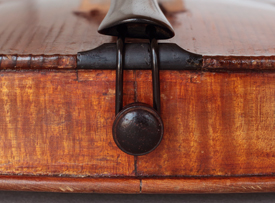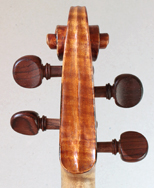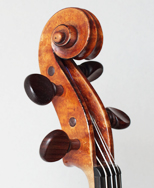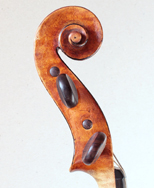|
Violin by Gaetano Chiocchi, Padua, Italy, 1870
Made for Cesare Trombini
Description
— Robust
This violin's remarkably broad model (36.5 cm) pays homage to Maggini,
but with very shallow ribs (26-28 mm) and low arches, which give it an unusually flat appearance.
At the bottom of the symmetrical two-piece back, a dedication to Cesare Trombini is inlaid
into a third piece of wood
(with imagination, one can see the violin's legs open).
The wide-grained spruce of the belly is "backwards" — its annual rings narrowing towards the edges.
Similarly, the maple of the head is turned "backwards" — its stripes showing on the front and back sides
of the scroll. The soundholes sit surprisingly low and far from the flanks,
 Portrait of Cesare Trombini, oil painting by Domenico Peterlin.
Musei Civici of Padua. their cut slightly angled towards the sides of the body.
Plates are quite thick, especially the back (5.2 mm in the soundpost area), and extend over the
rib line by as much as 4 mm. Typical of the Venice region, and of Chiocchi, the
triple purfling (black-white-black-white-black) is worth noting.
The overall impression is of a bold, highly personal, completely original violin.
Cesare Trombini (1835-1898) was a violinist and opera conductor.
Son of a famed surgeon, he committed his life to music, and by age 10 was already a violin prodigy.
He later formally studied classical music in Vienna and violin technique with Joseph Mayseder.
In 1856, he toured Europe with
Giovanni Bottesini "the Paganini of double bass." My guess is that the low
sound of the double bass must have moved him.
In fact, he decided to abandon his virtuoso career soon after their return.
 Chiocchi dedicated this violin, his #32, to virtuoso Cesare Trombini. I imagine that Trombini asked his friend Chiocchi — they had both played in
the orchestra of opera house La Fenice in Venice (Trombini as concertmaster) —
to build a violin with a deep voice reminiscent of the double bass...
hence the large, Maggini-esque pattern of our violin.
Trombini went on to become an acclaimed orchestra conductor throughout Europe.
In 1874 he immigrated to Poland where he became the director of the Imperial Opera House
at Warsaw — and also taught voice, composition, and conducting at the Warsaw Conservatory.
Among others, he conducted the Polish premiere of Verdi's Requiem in 1876 and of
Wagner's Lohengrin in 1879.
He likewise introduced Russian audiences to contemporary new works in St-Petersburg,
where he held the post of Opera Director from 1881-1890.
He left many compositions for violin, mainly virtuoso pieces inspired by opera arias.
Gaetano Chiocchi (1814-1881) was at the pinnacle of his career when he
made this violin in 1870.
His reputation was that of the best maker and restorer in Italy.
Being a musician himself, he understood musicians and was much appreciated by them.
He had built a violin for Camillo Sivori a few years before this one, but without decorations.
Engraving the dedicatee's name into the body of the
violin seems quite obvious now, but no maker had done it before (that I'm aware of).
Chiocchi's vast education (humanities, chemistry, medicine, violinist) and life
experience (theatre director, political activist, prisoner of war) nourished his freedom of expression.
Here's a wonderful example of a violin maker who successfully integrated invention
into tradition.
 Gaetano Chiocchi's initials, "CG" were branded in several places,
including the pegbox.  The original saddle was inset into the ribs. On this picture, the exceptionally
wide grain of the top is noticeable.
This violin's tone is powerful, very dark, and open. The low range is amazingly
deep, but the high
range still sounds high and bright like a normal violin. I'd say the E string sounds
like a dramatic soprano, the A string like an earthy mezzo-soprano, the D string like
an Italian tenor, and the G string like a velvety bass-baritone. There is a definite
step in sound color between the strings, so one must decide fingerings accordingly.
It's not an easy violin to play.
As a shy person, I have to assume the extrovert in
me to speak with its unashamedly big voice. The high register is obnoxious,
focused and incredibly penetrating. The low register as well is incredibly penetrating,
yet a mellow, introspective tenderness smooths it. It's the sorrowful voice, full of
emotion, of someone who has earned wisdom.
 The label, signed by the maker.
The varnish is a marvel of color and texture. Once a luthier told me this is the
Cremonese varnish — whose recipe was supposedly lost at the end of the 18th century.
Is it possible that Giuseppe Ceruti, the last descendent of the classical Cremona makers,
had transmitted this knowledge to Gaetano Chiocchi? Certainly,
as Ceruti was already past 70 years old
when he encouraged Chiocchi (who himself was past 40) to take up the dying art of violin making,
around 1855. Of course I'm biased, but I haven't
seen such supple, soft, textured and vibrant varnish on any other violin. The color, very vivid,
almost saturated yet clear, is a sublime balance of brown, orange, and red, on a golden ground.
Acquisition
— A Chance Encounter
I was with friends in Florence, Italy when we decided to go see the
shop of Carlo Vettori,
just for fun. I was by no means searching for a violin. When I held this one, I thought
it was the ugliest violin I had ever seen. But Mr. Vettori insisted I try it... After playing the
first open G string I was in love! I had never heard such depth and sweetness. The violin
suddenly appeared beautiful. Many people discouraged me from acquiring a large
violin, but I followed my heart and came back the following weekend to purchase it.
Now it's been 33 years, and I've never regretted.
 |
|
 |
|
 |
|
 |
|
 |
| The pegbox is elongated, in keeping with the violin's large body size. The eyes of the spiral were originally painted in black, along with the outside chamfers of the head. The back fluting keeps going around the volutes into the throat, seamlessly continuing into the turns of the scroll. |
Bibliography
More about this Violin:
- "Liuteri & Sonadori - Venezia 1750-1870" by Stefano Pio, Venice Research, 2002,
illustrated on pages 266-269.

- The
Cozio Archive on Tarisio.com, violin number 55431.

More about Gaetano Chiocchi:
- "Liuteria Italiana 1860-1960 - II Lombardia e Veneto" by Eric Blot, Editrice Turris,
Cremona, 1995, pages 263-267.

- "Italian Violin Makers" by Walter Hamma, 1964, 8th edition by Messiah Enterprise, 2005,
pages 129-133.

- "Liuteria Italiana da Scoprire" by Artemio Versari, Edizioni Novecento, Cremona,
2012, page 118.

- "Patriotic Fervour" on ArianeJamesFotografie.nl by Jan James,
The Strad, April 1997, vol. 108,
no. 1284, pages 396-399.

- The Cozio Archive about Gaetano Chiocchi on
Tarisio.com.

- Gaetano Chiocchi on
LiutaiWiki.BlogSpot.ch.

- "The Brompton's
Book of Violin and Bow Makers" on Amati.com by John Dilworth, Ed. John Milnes, London,
2012, page 119.
- Violin by Gaetano Chiocchi, 1871, #37, on Bromptons.co.

- "Gaetano Chiocchi" on Books.Google.com by Wilhelm Joseph von Wasielewski,
Allgemeine Musikalische Zeitung,
No. 30, Leipzig, 24 July 1872, pages 473-475.
- "Biografia degli Artisti Padovani" on Archive.org by Napoleone Pietrucci,
Padua, 1858, pages 78-79.
- "Violinmakers in Italy - From the 19th Century to the Present" by Gualtiero Nicolini,
Alberto Perdisa Editore, Bologna, 2008, page 227.
- "Known Violin Makers" by John H. Fairfield, 1942, Virtuoso Publications,
Richmond, VA, USA, seventh edition, 2006, pages 19 & 259.
- "Universal Dictionary of Violin and Bow Makers" by William Henley, Amati Publishing Ltd,
Tunbridge Wells, England, 1973, reprinted 1997, page 232.
- "Die Geigen- und Lautenmacher vom Mittelalter bis zur Gegenwart" on
Archive.org by Willibald von Lütgendorff, volume 2, Frankfurter Verlags-Anstalt,
Frankfurt am Main, Germany, third edition, 1922, page 80.
- "Dictionnaire Universel des Luthiers" by René Vannes, volume 1,
Les Amis de la Musique, Brussels, second edition, 1951, page 61.
More about Cesare Trombini:
- Photograph of Cesare Trombini on Cyfrowe.mnw.art.pl, taken by Jan Mieczkowski
in Varsaw, 1892.

- Wikipedia about Cesare Trombini,
Original in Russian, Translation
in English.
- "The Grand Theatre in Warsaw"
on Archiv.Ub.Uni-Heidelberg.de by Jerzy Miziołek, Teatr Wielki - Opera Narodowa,
Warsaw, 2015, pages 277, 327, 339, 359, 739.

- Biography of Cesare Trombini on Batuty.Instrumenty.edu.pl,
Original in Polish, Translation
in English.
- Cesare Trombini's baton on Batuty.Instrumenty.edu.pl,
Original in Polish, Translation
in English.

- "Biografia degli Artisti Padovani" on Archive.org by Napoleone Pietrucci,
Padua, 1858, pages 270-271.
- "I Maestri di Musica Italiani del Secolo XIX"
on Books.Google.com by Giovanni Masutto, Gio. Cecchini, Venice, third edition, 1884,
page 189.
- "Goplana"
on Ispan.pl, opera by Władysław Żeleński, Facsimile Edition,
Instytut Sztuki Polskiej Akademii Nauk, Warsaw, 2016,
pages X, XIII, XV, XVII-XIX.

- "Dyrygenci polscy i obcy w Polsce, działający w XIX i XX wieku" by
Leon Tadeusz Błaszczyk, Polskie Wydawnictwo Muzyczne, Krakow, Poland,
1964.
- "Romantyzm - Historia Muzyki Polskiej, Tom V, cz. 2a, 1850-1900" by Irena Poniatowska,
Narodowe Centrum Kultury, Sutkowski Edition, Warsaw, 2013.
- Cesare Trombini on
IMSLP.org
|
Measurements & DataMaker: Gaetano Chiocchi (1814-1881)Made in: Padua, Veneto, ItalyYear: 1870Number: 32Name: the "Trombini"Made For: Cesare Trombini (1835-1898)Back Length: 365 mm *Upper Bouts: 172 mm *Middle Bouts: 118 mm *Lower Bouts: 217 mm *Stop Length: 200 mmRib Height at Neck: 26 mm *Rib Height at Endpin: 28 mm *Thickness of the Top: 3.4 mmThickness of the Back: 5.2 mmF-hole Length: 78.2 mm *Distance Between F-holes: 40.5 mm *Distance Edge-Purfling: 3.5 mmScroll Width: 42 mm *Weight: 437 gramsLabel:
GAETANO CHIOCCHI N° 32
G.Chiocchi fece in Padova 1870Brand: Branded "CG" in the pegbox.Inlay: Inlaid into the lower back,
"N° 32
G. CHIOCCHI A C. TROMBINI
PADOVA 1870."
Triple purfling.Condition: Soundpost crack on top (repaired with a patch). Original neck, reshaped and reset. Rebushed pegs. Possibly original tailpiece.Restoration: Claude Lebet, La-Chaux-de-Fonds, Switzerland, 1992.
Horst Kloss, Needham, MA, USA, 2003.
Pierre Mastrangelo, Lausanne, Switzerland, 2009.Certificate: Carlo Vettori, Florence, Italy, 1991.
* measured with a caliper
|
|















